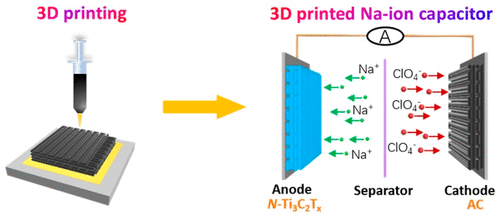Our official English website, www.x-mol.net, welcomes your
feedback! (Note: you will need to create a separate account there.)
3D Printing of Porous Nitrogen-Doped Ti3C2 MXene Scaffolds for High-Performance Sodium-Ion Hybrid Capacitors.
ACS Nano ( IF 15.8 ) Pub Date : 2020-01-07 , DOI: 10.1021/acsnano.9b08030 Zhaodi Fan 1 , Chaohui Wei 1 , Lianghao Yu 1 , Zhou Xia 1, 2 , Jingsheng Cai 1 , Zhengnan Tian 1 , Guifu Zou 1 , Shi Xue Dou 3 , Jingyu Sun 1, 2
ACS Nano ( IF 15.8 ) Pub Date : 2020-01-07 , DOI: 10.1021/acsnano.9b08030 Zhaodi Fan 1 , Chaohui Wei 1 , Lianghao Yu 1 , Zhou Xia 1, 2 , Jingsheng Cai 1 , Zhengnan Tian 1 , Guifu Zou 1 , Shi Xue Dou 3 , Jingyu Sun 1, 2
Affiliation

|
3D printing technology has stimulated a burgeoning interest to fabricate customized architectures in a facile and scalable manner targeting wide ranged energy storage applications. Nevertheless, 3D-printed hybrid capacitor devices synergizing favorable energy/power density have not yet been explored thus far. Herein, we demonstrate a 3D-printed sodium-ion hybrid capacitor (SIC) based on nitrogen-doped MXene (N-Ti3C2Tx) anode and activated carbon cathode. N-Ti3C2Tx affording a well-defined porous structure and uniform nitrogen doping can be obtained via a sacrificial template method. Thus-formulated ink can be directly printed to form electrode architecture without the request of a conventional current collector. The 3D-printed SICs, with a large areal mass loading up to 15.2 mg cm-2, can harvest an areal energy/power density of 1.18 mWh cm-2/40.15 mW cm-2, outperforming the state-of-the-art 3D-printed energy storage devices. Furthermore, our SIC also achieves a gravimetric energy/power density of 101.6 Wh kg-1/3269 W kg-1. This work demonstrates that the 3D printing technology is versatile enough to construct emerging energy storage systems reconciling high energy and power density.
中文翻译:

用于高性能钠离子混合电容器的多孔氮掺杂Ti3C2 MXene支架的3D打印。
3D打印技术激发了人们迅速兴起的兴趣,以针对广泛的储能应用的便捷,可扩展的方式制造定制架构。然而,迄今为止尚未探索协同产生有利的能量/功率密度的3D打印混合电容器器件。在本文中,我们演示了基于氮掺杂的MXene(N-Ti3C2Tx)阳极和活性炭阴极的3D打印钠离子混合电容器(SIC)。可以通过牺牲模板法获得具有良好定义的多孔结构和均匀氮掺杂的N-Ti3C2Tx。这样配制的油墨可以直接印刷以形成电极结构,而无需常规的集电器。3D打印的SIC具有高达15.2 mg cm-2的大面积质量,可以收获1.18 mWh cm-2 / 40的面积能量/功率密度。15 mW cm-2,优于最先进的3D打印能量存储设备。此外,我们的SIC还实现了101.6 Wh kg-1 / 3269 W kg-1的重量能量/功率密度。这项工作表明3D打印技术具有足够的通用性,可以构建兼顾高能量和功率密度的新兴能量存储系统。
更新日期:2020-01-07
中文翻译:

用于高性能钠离子混合电容器的多孔氮掺杂Ti3C2 MXene支架的3D打印。
3D打印技术激发了人们迅速兴起的兴趣,以针对广泛的储能应用的便捷,可扩展的方式制造定制架构。然而,迄今为止尚未探索协同产生有利的能量/功率密度的3D打印混合电容器器件。在本文中,我们演示了基于氮掺杂的MXene(N-Ti3C2Tx)阳极和活性炭阴极的3D打印钠离子混合电容器(SIC)。可以通过牺牲模板法获得具有良好定义的多孔结构和均匀氮掺杂的N-Ti3C2Tx。这样配制的油墨可以直接印刷以形成电极结构,而无需常规的集电器。3D打印的SIC具有高达15.2 mg cm-2的大面积质量,可以收获1.18 mWh cm-2 / 40的面积能量/功率密度。15 mW cm-2,优于最先进的3D打印能量存储设备。此外,我们的SIC还实现了101.6 Wh kg-1 / 3269 W kg-1的重量能量/功率密度。这项工作表明3D打印技术具有足够的通用性,可以构建兼顾高能量和功率密度的新兴能量存储系统。











































 京公网安备 11010802027423号
京公网安备 11010802027423号